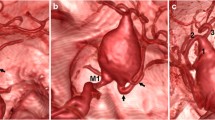Abstract
De novo aneurysms associated with superficial temporal artery (STA)-middle cerebral artery (MCA) bypass are an extremely rare complication of direct revascularization surgery for moyamoya disease (MMD). The basic pathology of MMD includes fragility of the intracranial arterial wall characterized by medial layer thinness and waving of the internal elastic lamina. However, the incidence of newly formed aneurysms at the site of anastomosis currently remains unknown. Among 317 consecutive direct/indirect combined revascularization surgeries performed for MMD, we encountered a 52-year-old woman manifesting a de novo aneurysm adjacent to the site of anastomosis 11 years after successful STA-MCA bypass with encephalo-duro-myo-synangiosis (EDMS). Although the patient remained asymptomatic, the aneurysm gradually increased in diameter to more than 6 mm with the formation of a daughter sac, and a computational fluid dynamic study revealed low wall shear stress at the aneurysm dome. The patient underwent microsurgical clipping of the aneurysm using a neuro-navigation system that permitted the minimally invasive dissection of the temporal muscle flap used for EDMS at the site of the aneurysm without affecting pial synangiosis. The aneurysm was successfully occluded using a titanium clip without complications. The postoperative course was uneventful, and the patient was discharged without neurological deficits. De novo aneurysms associated with STA-MCA bypass for MMD may be safely treated with microsurgical clipping, even in cases initially managed by a combined revascularization procedure that includes complex pial synangiosis. We recommend the application of the neuro-navigation system for the maximum preservation of pial synangiosis during this procedure.


Similar content being viewed by others
References
Cho WS, Kim JE, Kim CH, Ban SP, Kang HS, Son YJ, Bang JS, Sohn CH, Paeng JC, Oh CW (2014) Long-term outcomes after combined revascularization surgery in adult moyamoya disease. Stroke 45:3025–3031
Cho WS, Kim JE, Paeng JC, Suh M, Kim YI, Kang HS, Son YJ, Bang JS, Oh CW (2016) Can combined bypass surgery at middle cerebral artery territory also save anterior cerebral artery territory in adult moyamoya disease? Neurosurgery
Eom KS, Kim DW, Kang SD (2010) Intracerebral hemorrhage caused by rupture of a giant aneurysm complicating superficial temporal artery-middle cerebral artery anastomosis for moyamoya disease. Acta Neurochir 152:1069–1073
Fujimura M, Kaneta T, Mugikura S, Shimizu H, Tominaga T (2007) Temporary neurologic deterioration due to cerebral hyperperfusion after superficial temporal artery-middle cerebral artery anastomosis in patients with adult-onset moyamoya disease. Surg Neurol 67:273–282
Fujimura M, Shimizu H, Mugikura S, Tominaga T (2009) Delayed intracerebral hemorrhage after superficial temporal artery-middle cerebral artery anastomosis in a patient with moyamoya disease: possible involvement of cerebral hyperperfusion and increased vascular permeability. Surg Neurol 71:223–227
Fujimura M, Shimizu H, Inoue T, Mugikura S, Saito A, Tominaga T (2011) Significance of focal cerebral hyperperfusion as a cause of transient neurologic deterioration after EC-IC bypass for moyamoya disease: comparative study with non-moyamoya patients using 123I-IMP SPECT. Neurosurgery 68:957–965
Fujimura M, Tominaga T (2012) Lessons learned from moyamoya disease: outcome of direct/indirect revascularization surgery for 150 affected hemispheres. Neurol med Chir (Tokyo) 52:327–332
Fujimura M, Tominaga T (2015) Current status of revascularization surgery for Moyamoya disease: special consideration for its “internal carotid-external carotid (IC-EC) conversion” as the physiological reorganization system. Tohoku J Exp med 236:45–53
Nishimoto T, Yuki K, Sasaki T, Murakami T, Kodama Y, Kurisu K (2005) A ruptured middle cerebral artery aneurysm originating from the site of anastomosis 20 years after exaracranial-intracranial bypass for moyamoya disease. Surg Neurol 64:261–265
Oka K, Yamashita M, Sadoshima S, Tanaka K (1981) Cerebral haemorrhage in Moyamoya disease at autopsy. Virchows Arch A Pathol Anat Histol 392:247–261
Omodaka S, Sugiyama S, Inoue T, Funamoto K, Fujimura M, Shimizu H, Hayase T, Takahashi A, Tominaga T (2012) Local hemodynamics at the rupture point of cerebral aneurysms determined by computational fluid dynamics analysis. Cerebrovasc Dis 34:121–129
Rashad S, Fujimura M, Niizuma K, Endo H, Tominaga T (2016) Long term follow-up of pediatric Moyamoya disease treated by combined direct-indirect revascularization surgery: single institute experience with surgical and perioperative management. Neurosurg Rev 39:615–623
Takagi Y, Kikuta K, Nozaki K, Hashimoto N (2007) Histological features of middle cerebral arteries from patients treated for Moyamoya disease. Neurol med Chir (Tokyo) 47:1–4
Yokota H, Yokoyama K, Noguchi H (2016) De novo aneurysm associated with superficial temporal artery to middle cerebral artery bypass: report of two cases and review of literature. World Neurosurg 92:583.e7–583.e12
Author information
Authors and Affiliations
Corresponding author
Ethics declarations
Funding
This study was supported by JSPS KAKENHI Grant Number 26462150 from the Ministry of Health, Labour and Welfare, Japan.
Disclosure of the potential conflict of interest
The authors declare that they have no conflict of interest.
Research involving human participants and/or animals
The MRI/MRA and catheter angiography are routine postoperative examinations, which are all covered by medical insurance in Japanese healthcare system. All procedures are performed in accordance with the Declaration of Helsinki.
Informed consent
Informed consent was obtained from an individual participant included in the study.
Financial and material support
This study was supported by JSPS KAKENHI Grant Number 426462150 and AMED Grant Number J160001258.
No portion of this work has been presented previously.
Rights and permissions
About this article
Cite this article
Aburakawa, D., Fujimura, M., Niizuma, K. et al. Navigation-guided clipping of a de novo aneurysm associated with superficial temporal artery-middle cerebral artery bypass combined with indirect pial synangiosis in a patient with moyamoya disease. Neurosurg Rev 40, 517–521 (2017). https://doi.org/10.1007/s10143-017-0866-4
Received:
Revised:
Accepted:
Published:
Issue Date:
DOI: https://doi.org/10.1007/s10143-017-0866-4




